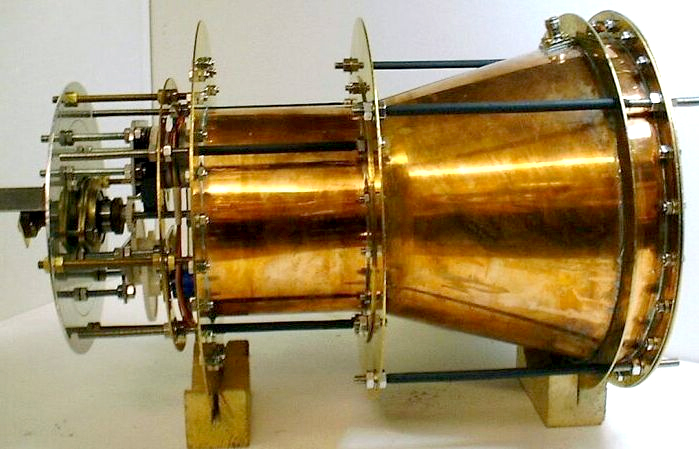The radio frequency resonant cavity thruster, otherwise known as the electromagnetic drive, or EM Drive, that so flummoxed scientists around the world over the past couple of years, is set to have its first test in space in the coming months. It's creator has booked a flight aboard a CubeSat at some point in the near future.
The EM drive was first proposed by Roger Shawyer in 1999, to much derision. The very idea of creating a drive that can propel something without fuel being exhausted, contravenes Newton's third law of motion, in that for every action, there is an equal an opposite reaction.
Source: EMdrive.com
Despite being seemingly impossible to physics as we understand it, Shawyer's idea was picked up by American inventor and chemical engineer, Guido Fetta and his drive proposed as a viable propulsion system a few years ago. Surprisingly though, people started to say it works. So in 2014 NASA took a look and even more surprisingly, couldn't find much fault with it.
In fact, there's a lot of evidence to suggest we are on the cusp of a peer reviewed study being released by NASA (via DigitalTrends), which explains what tests were completed on the drive and what methods were used, which allows other scientists to attempt to recreate the results. That would lend a lot of credence to the drive and would likely accelerate plans to test it in space itself.
If successful, the EM drive could change space travel almost overnight. With enough electricity, we could travel to new planets in weeks, rather than months or years and potentially even consider sending denizens to new stars.
Discuss on our Facebook page, HERE.
KitGuru Says: Propulsion without fuel would likely have huge ramifications here on Earth too. It's probably going to turn out that this is all nonsense, but if it doesn't, it could change everything.
 KitGuru KitGuru.net – Tech News | Hardware News | Hardware Reviews | IOS | Mobile | Gaming | Graphics Cards
KitGuru KitGuru.net – Tech News | Hardware News | Hardware Reviews | IOS | Mobile | Gaming | Graphics Cards




Most likely the engine appears to work due to EMI measurements making it look like there is a net gain in momentum.
I really am itching to see if this really works in a micro gravity environment
Kitguru, As I understand, the engine needs energy, be it from a gas generator or a nuclear reactor in the form of electricity. But by putting out thrust – no matter is thrown out of the engine that does the propulsion, just a form of radio waves.
That’s why bigger versions are soon to be tested, so that errors like would be much smaller than the expected “thrust”.
As explained by the inventor on his website (www.emdrive.com), there is no mystery to how this thing works.
It is certainly not “seemingly impossible to physics as we understand it”.
To be fair, it’s not exactly an absurd theory. From what I understand, this thing is akin to using electromagnetic emissions to “push” the craft.
One I scavenge from rather frequently for use in my own hard science fiction writing, the disjunction drive, seems as silly–but has a fair amount of theoretical basis for how it could be plausible.
Heck, you can use a -laser- to propel an object.
We barely understand gravity, I wouldn’t be surprised to hear that a jumped up radio could, in fact, push a ship through space.
The problem is the energy levels required. Coveting any energy into kinetic motion is normally horribly inefficient (loss > *10) and trying to get radio waves to produce enough energy to propel an object is most likely obscene.
To be fair, a good chunk of that comes from our power generation methods and lack of appropriate near-room temp superconductors. I’d hazard a guess that when we pass that hurdle (provided we don’t blow ourselves up first), most theoretical forms of propulsion won’t cause an issue.
That said, people said as much about lasers being used as weapons 30 years ago, now the US Navy has a weaponized laser on an active warship.
Perhaps, as a sci fi writer, I’m just too optimistic (HAH!) about our adaptability as a species.
But that hurdle is an enormous challenge and no one has a clue about how to get around it. I think it is more akin to “fusion is 30 years away” rather than “lasers are 30 years away” :p A laser just needed one breakthrough (sold state rather than chemical), where as fusion sadly needs a vast number of breakthroughs to achieve.
Touche.
Pedantic note though:
Fusion really isn’t that far away, which is awesome. There’s a lot of stubborn ideas of why it’s dangerous (it’s not, compared to a fission reactor it’s something you could build into a baby’s room–compared to coal it’s still pretty safe) out there from people that can’t tell the difference between fission, fusion, and the hole they expel solid waste from; and there are currently operational (experimental) torus reactors that are fairly close to being able to long-term sustain a hot fusion reaction that puts out more energy than it requires.
That said, there are pulsed chemical lasers that are just as powerful as solid state lasers.
It’s amazing the things you learn researching for science fiction novels–I learned more in one week researching lasers as a viable weapons technology than I did when I was interested in them as amusing playthings.